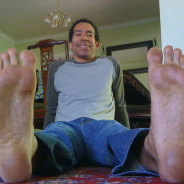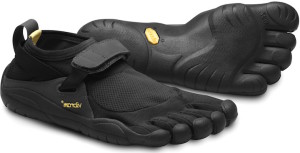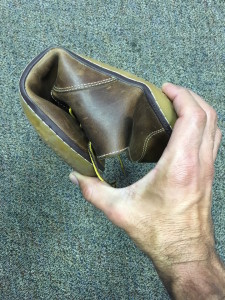January 27th, 2016
Should I Bare My Sole? Reflections on Patient-Provider Trust and Barefoot Running
Scott Cuyjet, RN, MSN, FNP-C
; [/php]/images/AU000_scuyjet.jpg)
Scott Cuyjet, RN, MSN, FNP-C, practices adolescent medicine in the San Francisco Bay area.
In my own experience as the patient doing something out of the norm, I am a barefoot/minimalist runner. And I’d like to share my own story here with some background information in case you encounter one of “us” in your practice. That way you can be better prepared, so you don’t have a negative gut reaction that comes out verbally or nonverbally.
My journey into barefoot running started in May of 2005, after my first and only marathon, which gave me a horrible blister on my right arch, and a painful second half of said marathon. It was after this that I read an article in Runner’s World magazine about a man named Ken Bob Saxton who lives in Long Beach, California — an article that changed how I run to this day. After reading the article, I went to his website, and read about other barefoot runners throughout history and how their form is more natural and gentle. The thing that was most intriguing about running barefoot was that all of the people on his bulletin board claimed they no longer experienced injuries like shin splints, joint pain, twisted ankles, and blisters. I had been chronically plagued by knee pain since I started running at the age of 8, which I was told was from my flat feet causing me to over-pronate. So to minimize my discomfort, I had tried every over-the-counter orthotic, custom orthotic, and motion-control shoe — with little to no relief, but I kept running anyway. I also had two pairs of shoes that I alternated between each day and tracked their mileage so that the midsole would not get too compressed and make me even more prone to injury. Lastly, I looked for the softest surface to run on so I would not hurt myself while “pounding the pavement.”
A minimalist runner on the other hand, or foot, is one who wears the least amount of substance between his/her foot and the ground while running. It may be the Vibram Five Fingers, the Nike Free or one of its competitors, or a modernized version of the huarache sandal worn by the Tarahumara Indians in the book Born to Run (such as Xeroshoes). One can purchase minimalist shoes for general wear as well.
I wear my Vibrams when I am running in an unknown location, on a trail, or the temp drops below 40 degrees, but most of the time I am barefoot. I tried some huaraches/Xeroshoes, but they did not work for me. To maintain general foot strength, I stay barefoot as much as possible, or close to it. I wear vivobarefoot shoes at work and flip-flops everywhere else. I also ride my single-speed bike barefoot or in Vibrams. In 2012 there was a lawsuit brought against the Vibram company for, “[Allegedly making] false and unsubstantiated claims about the health benefits of its glove-like footwear.” In this article I found, the author states, “A friend of mine owns a running shoe store and he reports sales of Vibram Five Fingers have all but ceased,” but I feel that the people injured either were being used by liability lawyers to make a buck or did not use any common sense.
As far as the latter, when I started, I read a lot before ditching my shoes, and what I read told me to start slow. At the time of my switch I was running 9-13 miles 4 days a week. I cut my mileage back to 2-3 miles and increased 10% a week if my feet and legs allowed it. Some of you may be thinking, he probably runs really slow, or does not run very far, so I am including some of my barefoot race PRs: 2 miles in a sprint triathlon — 9:27 (4:44/mi); 5K — 17:49 (5:44/mi); 12K — 44:37 (5:59/mi), half marathon — 1:28 (6:47/mi). When training for my half marathons, my long run before a race was 18 miles.
Since I began running barefoot and in my Vibrams, I get lots of stares and the occasional request to take a picture, but I have had none of the knee pain that plagued me in shoes. I have also not had any foot, ankle, shin, or hip pain, or blisters. I step on a piece of glass maybe a few times a year so I carry tweezers, pick it out, and keep running. I also have not had any foot infections from these impalements.
When my primary provider found out about how I ran, he was not judgmental at all. This enabled me to feel safe discussing it with him. On the other hand, a nurse co-worker assured me that I was going to wind up in the hospital with a staph infection. If she had been my provider, I would have either switched to someone else or been very careful about what I shared with her in the future.
Categories: Nurse Practitioner, Patient Care
Tags: barefoot running, patient-provider communication, patient-provider trust
You can follow any responses to this entry through the RSS 2.0 feed. Both comments and pings are currently closed.
2 Responses to “Should I Bare My Sole? Reflections on Patient-Provider Trust and Barefoot Running”

NP/PA Bloggers
Elizabeth Donahue, RN, MSN, NP‑C
Alexandra Godfrey, BSc PT, MS PA‑C
Emily F. Moore, RN, MSN, CPNP‑PC, CCRN
Advanced practice clinicians treating patients in a variety of settings and specialties
Learn more about In Practice: Reflections from NPs and PAs.
-
 NEJM Journal Watch — Recent General Medicine Articles
NEJM Journal Watch — Recent General Medicine Articles NEJM Journal Watch — Recent Pediatrics and Adolescent Medicine Articles
NEJM Journal Watch — Recent Pediatrics and Adolescent Medicine Articles-
Tag Cloud
- addiction adolescent health advanced practice provider clinical role Communication compensation deep brain stimulation diagnostic test discrimination Emergency Medicine empathy end of life Falls Geriatrics gun violence Haiti healthcare access health care quality humanity intensive care intracranial aneurysm legislation lifestyle modification longterm care Massachusetts medical knowledge negotiation neurosurgery NPAEP obesity opioid abuse Parkinson's disease patient-provider communication patient navigation pediatrics performance personal growth practice privileges primary care professional title retirement running team-based health care toxic work culture Vaccination




Steve great story. i own a store selling only minimal shoes and would love to share your store. i’m also a practicing physician afrundoc@gmail.com
Mark
Thanks for reading Mark. I will PM you about your comment.
Scott